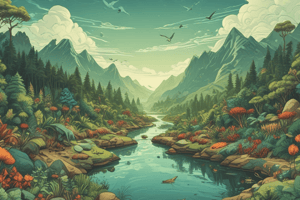Podcast
Questions and Answers
What is an ecosystem composed of?
What is an ecosystem composed of?
- Only living organisms
- A community of living and non-living things interacting with each other in a specific environment (correct)
- Only non-living things
- Only plants and animals
Which of the following is NOT a type of ecosystem?
Which of the following is NOT a type of ecosystem?
- Marine Ecosystems
- Atmospheric Ecosystems (correct)
- Freshwater Ecosystems
- Terrestrial Ecosystems
What is the role of decomposers in an ecosystem?
What is the role of decomposers in an ecosystem?
- To regulate temperature
- To consume plants and animals
- To break down organic matter (correct)
- To produce oxygen
Which ecosystem service is responsible for providing food and water?
Which ecosystem service is responsible for providing food and water?
What is an example of a biotic factor in an ecosystem?
What is an example of a biotic factor in an ecosystem?
What is the term for the process by which nutrients are circulated through an ecosystem?
What is the term for the process by which nutrients are circulated through an ecosystem?
What is the primary function of a beam in a structural system?
What is the primary function of a beam in a structural system?
What is the effect of tension on a material?
What is the effect of tension on a material?
What is the result of compression on a material?
What is the result of compression on a material?
What is the effect of torsion on an object?
What is the effect of torsion on an object?
What type of beam is supported at both ends?
What type of beam is supported at both ends?
What type of force causes an object to deform by bending or curving?
What type of force causes an object to deform by bending or curving?
What is the effect of bending on a material?
What is the effect of bending on a material?
What is a common cause of torsion in an object?
What is a common cause of torsion in an object?
Flashcards are hidden until you start studying
Study Notes
Ecosystems of Planet Earth
What is an Ecosystem?
- A community of living and non-living things interacting with each other in a specific environment
- Includes plants, animals, microorganisms, soil, water, air, and sunlight
Types of Ecosystems
- Terrestrial Ecosystems
- Forests
- Grasslands
- Deserts
- Tundras
- Freshwater Ecosystems
- Rivers
- Lakes
- Wetlands
- Marine Ecosystems
- Coral reefs
- Estuaries
- Open ocean
- Artificial Ecosystems
- Agricultural ecosystems
- Urban ecosystems
Components of an Ecosystem
- Biotic Factors
- Producers (plants, algae, phytoplankton)
- Consumers (herbivores, carnivores, omnivores)
- Decomposers (bacteria, fungi)
- Abiotic Factors
- Light
- Temperature
- Water
- Soil
- Atmosphere
Ecosystem Services
- Supporting Services
- Nutrient cycling
- Soil formation
- Oxygen production
- Provisioning Services
- Food
- Water
- Medicine
- Regulating Services
- Climate regulation
- Pest control
- Natural hazard regulation
- Cultural Services
- Recreation
- Tourism
- Spiritual values
Ecosystems of Planet Earth
What is an Ecosystem?
- A community of living and non-living things interacting with each other in a specific environment
- Includes plants, animals, microorganisms, soil, water, air, and sunlight
Types of Ecosystems
- Terrestrial Ecosystems: Forests, Grasslands, Deserts, Tundras
- Freshwater Ecosystems: Rivers, Lakes, Wetlands
- Marine Ecosystems: Coral reefs, Estuaries, Open ocean
- Artificial Ecosystems: Agricultural ecosystems, Urban ecosystems
Components of an Ecosystem
Biotic Factors
- Producers: plants, algae, phytoplankton
- Consumers: herbivores, carnivores, omnivores
- Decomposers: bacteria, fungi
Abiotic Factors
- Light
- Temperature
- Water
- Soil
- Atmosphere
Ecosystem Services
Supporting Services
- Nutrient cycling
- Soil formation
- Oxygen production
Provisioning Services
- Food
- Water
- Medicine
Regulating Services
- Climate regulation
- Pest control
- Natural hazard regulation
Cultural Services
- Recreation
- Tourism
- Spiritual values
Structures and Forces
Beam Design
- Beams resist loads perpendicular to their longitudinal axis and can be horizontal or sloping.
- Simply supported beams are supported at both ends, while cantilever beams are fixed at one end and free at the other.
- Overhanging beams extend beyond their support at one or both ends.
- Beam design involves selecting the appropriate material, shape, and size to resist various types of loads.
Forces
Tension
- Tension is a force that stretches or pulls a material apart, causing it to increase in length and reduce in cross-sectional area.
- External forces, such as pulling or stretching, and internal forces, such as thermal expansion, can cause tension.
- Tension can cause material failure, such as fracture or yielding.
Compression
- Compression is a force that squeezes or presses a material together, causing it to decrease in length and increase in cross-sectional area.
- External forces, such as pushing or squeezing, and internal forces, such as thermal contraction, can cause compression.
- Compression can cause material failure, such as buckling or crushing.
Torsion
- Torsion is a twisting force that causes an object to rotate around its longitudinal axis, resulting in deformation and stress concentrations.
- External forces, such as torque or twisting moment, and internal forces, such as uneven heating or cooling, can cause torsion.
- Torsion can cause material failure, such as cracking or fracture.
Bending
- Bending is a force that causes an object to deform by bending or curving, resulting in curvature and deformation.
- External forces, such as transverse loads or point loads, and internal forces, such as residual stresses, can cause bending.
- Bending can cause material failure, such as cracking or fracture.
Studying That Suits You
Use AI to generate personalized quizzes and flashcards to suit your learning preferences.




